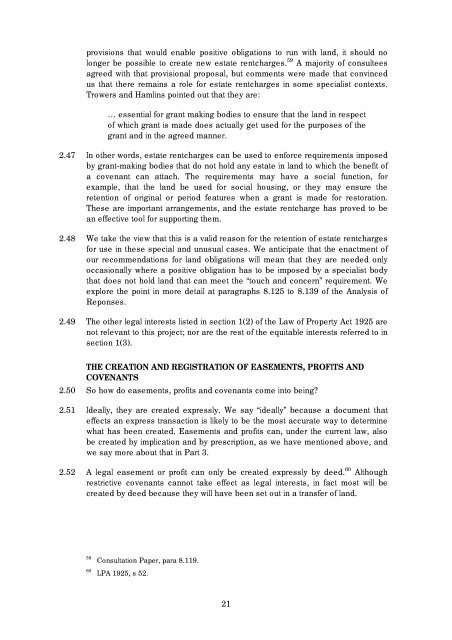Making Land Work: Easements, Covenants and ... - Law Commission
Making Land Work: Easements, Covenants and ... - Law Commission
Making Land Work: Easements, Covenants and ... - Law Commission
Create successful ePaper yourself
Turn your PDF publications into a flip-book with our unique Google optimized e-Paper software.
provisions that would enable positive obligations to run with l<strong>and</strong>, it should no<br />
longer be possible to create new estate rentcharges. 59 A majority of consultees<br />
agreed with that provisional proposal, but comments were made that convinced<br />
us that there remains a role for estate rentcharges in some specialist contexts.<br />
Trowers <strong>and</strong> Hamlins pointed out that they are:<br />
… essential for grant making bodies to ensure that the l<strong>and</strong> in respect<br />
of which grant is made does actually get used for the purposes of the<br />
grant <strong>and</strong> in the agreed manner.<br />
2.47 In other words, estate rentcharges can be used to enforce requirements imposed<br />
by grant-making bodies that do not hold any estate in l<strong>and</strong> to which the benefit of<br />
a covenant can attach. The requirements may have a social function, for<br />
example, that the l<strong>and</strong> be used for social housing, or they may ensure the<br />
retention of original or period features when a grant is made for restoration.<br />
These are important arrangements, <strong>and</strong> the estate rentcharge has proved to be<br />
an effective tool for supporting them.<br />
2.48 We take the view that this is a valid reason for the retention of estate rentcharges<br />
for use in these special <strong>and</strong> unusual cases. We anticipate that the enactment of<br />
our recommendations for l<strong>and</strong> obligations will mean that they are needed only<br />
occasionally where a positive obligation has to be imposed by a specialist body<br />
that does not hold l<strong>and</strong> that can meet the “touch <strong>and</strong> concern” requirement. We<br />
explore the point in more detail at paragraphs 8.125 to 8.139 of the Analysis of<br />
Reponses.<br />
2.49 The other legal interests listed in section 1(2) of the <strong>Law</strong> of Property Act 1925 are<br />
not relevant to this project; nor are the rest of the equitable interests referred to in<br />
section 1(3).<br />
THE CREATION AND REGISTRATION OF EASEMENTS, PROFITS AND<br />
COVENANTS<br />
2.50 So how do easements, profits <strong>and</strong> covenants come into being?<br />
2.51 Ideally, they are created expressly. We say “ideally” because a document that<br />
effects an express transaction is likely to be the most accurate way to determine<br />
what has been created. <strong>Easements</strong> <strong>and</strong> profits can, under the current law, also<br />
be created by implication <strong>and</strong> by prescription, as we have mentioned above, <strong>and</strong><br />
we say more about that in Part 3.<br />
2.52 A legal easement or profit can only be created expressly by deed. 60 Although<br />
restrictive covenants cannot take effect as legal interests, in fact most will be<br />
created by deed because they will have been set out in a transfer of l<strong>and</strong>.<br />
59 Consultation Paper, para 8.119.<br />
60 LPA 1925, s 52.<br />
21
















